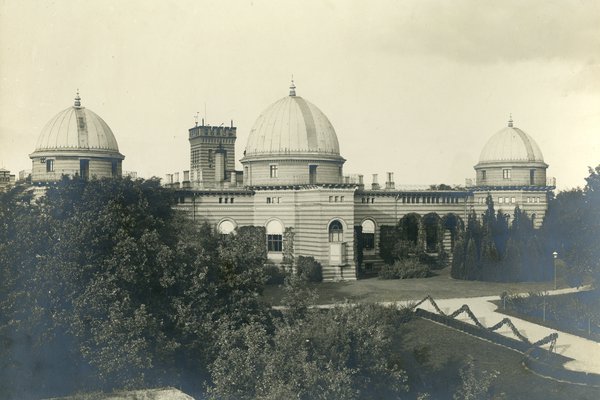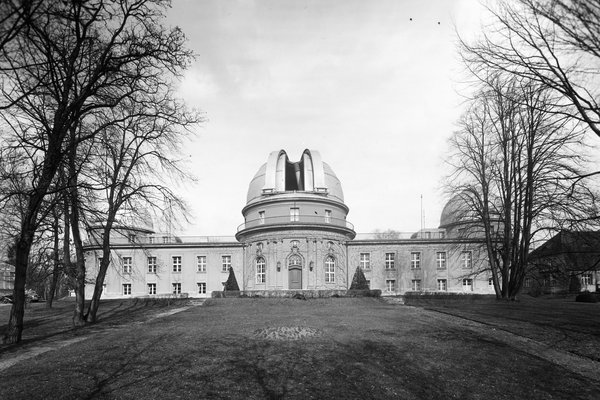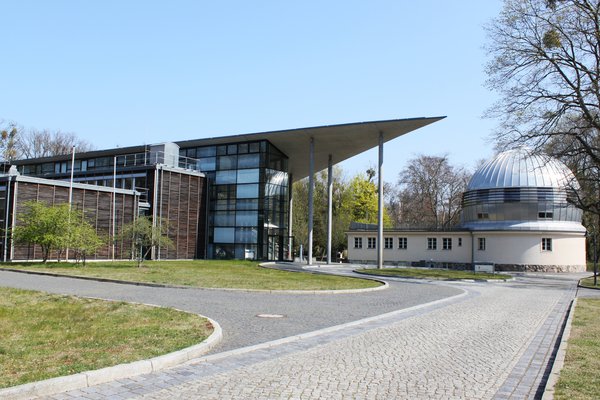History

New Berlin Observatory, Berlin, Lindenstraße. Architect: Karl Friedrich Schinkel
Credit: AIP/ArchivOrigin
The history of astronomy in Potsdam really began in Berlin, 325 years ago. Initiated by Gottfried W. Leibniz, on July 11, 1700 the “Brandenburgische Societät,” which later became the “Prussian Academy of Sciences,” was founded in Berlin by the Elector, Frederick III. Two months earlier, the monopoly on calculating the national calendar had provided funding for an observatory and by May 18 the first director, Gottfried Kirch, had been appointed. This happened quickly because the profit from the national calendar, calculated and sold by the observatory, funded the academy. This method of funding only continued until the beginning of the 19th century, but the calendar has continued to be calculated until very recently, and was only discontinued after Germany’s reunification in 1991.
The first observatory was built on Dorotheen Street in Berlin in 1711 and in 1835 a new observatory building, which was designed by the famous architect Karl Friedrich Schinkel, was completed on Linden Street (near Hallesches Tor). From 1827-28, Alexander von Humboldt promoted astronomy through his famous 'Kosmos' lectures, and played an important role in providing funding for both the observatory and its instruments.
The Berlin Observatory came to worldwide acclaim when Johann Gottfried Galle and Heinrich Louis d'Arrest discovered the planet Neptune in 1846. The discovery of canal rays by Eugen Goldstein in the physical laboratory of the observatory in 1886 and the discovery of the variation in the altitude of the Earth's pole by Karl Friedrich Küstnerr in 1888 were similarly important.
The last two scientific events took place when Wilhelm Julius Foerster was director of the observatory, which was attached to the University of Berlin at the time. He prepared the basis for the astronomical observatories in Potsdam, including the foundation of the Astrophysical Observatory Potsdam on the Telegrafenberg in 1874 and the relocation of the Berlin Observatory to Babelsberg in 1913.

The Astrophysical Observatory Potsdam (AOP) on the Telegrafenberg.
Credit: AIP/ArchivFoundation of the Astrophysical Observatory Potsdam (AOP)
In the middle of the 19th century, Gustav Kirchhoff and Robert Bunsen developed spectral analysis. It provided the possibility of obtaining information about the physical parameters and chemical abundances of stars through spectral analysis of their light. Foerster recognized these possibilities and, in 1871, initiated the construction of a solar observatory as a memorial to the crown prince, emphasizing the importance and benefit of solar research. This mandate was soon extended to the entirety of astrophysics.
The chosen site of the observatory was a hill south of Potsdam, known as the Telegrafenberg, where a relay station of the optical telegraph system for sending military information from Berlin to Koblenz had stood from 1832 to 1848. The Astrophysical Observatory Potsdam was founded on July 1, 1874. Before construction of the observatory had even begun, Gustav Spörer made solar observations from the tower of the former military orphanage in Potsdam’s Linden Street. Construction started in 1876, and the main building of the observatory and its equipment were completed in the autumn of 1879.
To begin with, a board of directors comprised of Wilhelm Julius Foerster, Gustav Kirchhoff and Arthur Auwers managed the AOP, but in 1882 Carl Hermann Vogel was appointed as sole director of the observatory. The main focus of his work was on stellar astrophysics. He was the first person to successfully determine radial velocities of stars photographically and, as a result, he discovered spectroscopic binaries.
In 1899, what was then the largest refractor in the world, with 80cm and 50cm lenses, manufactured by the firms of Steinheil and Repsold, was mounted in a 24m dome. It was inaugurated by the German emperor, Wilhelm II, with considerable celebration. Although the Great Refractor of Potsdam did not realize all the aspirations astronomers had for it, it is nonetheless worth mentioning the important discoveries of interstellar calcium lines in the spectrum of the spectroscopic binary delta Orionis by Johannes Hartmann in 1904, and the presence of stellar calcium emission lines, a hint towards understanding stellar surface activity, discovered by Gustav Eberhard and Hans Ludendorff in about 1900.
Ten years later, one of the most famous astrophysicists of the century, Karl Schwarzschild, became director of the observatory. In only a few years of work (he died of an illness in 1916) Schwarzschild made fundamental contributions to astrophysics and the general theory of relativity (GTR). Only a few weeks after Einstein’s publication, Schwarzschild found the first solution to the highly complicated system of Einstein’s equations. Now known as the “Schwarzschild solution,” it is of fundamental importance in the theory behind our understanding of black holes.
There are further close links between the AOP and Einstein's GTR. In 1881 Albert A. Michelson performed his experiments that attempted to demonstrate the movement of the Earth through the hypothetical ether in the cellar of the main building of the AOP. His negative results were only fundamentally reconciled in 1905 by Einstein's special relativity theory.
The aim of a solar tower telescope, built between 1921 and 1924, which was initiated by Erwin Finlay Freundlich and is now called the Einstein Tower, was to prove the redshift of spectral lines in the gravitational field of the sun – an effect proposed by Einstein's GTR. Although it was not yet possible to measure gravitational redshift at that time, important developments in solar and plasma physics were set in motion here and the architect, Erich Mendelsohn, created a unique scientific building with his peculiarly expressionistic tower design.
Besides the work done by Schwarzschild, in the following decades, important observational programmes such as the ''Potsdamer Photometrische Durchmusterung'' and the outstanding investigations by Walter Grotrian on the solar corona were recognized throughout the world.

Main building of the Berlin Observatory in Babelsberg.
Credit: AIP/ArchivRelocation of the Berlin Observatory to Babelsberg
At the end of the 19th century, the Berlin Observatory, originally built outside the city, had become surrounded by blocks of flats, making scientific observation almost impossible. Therefore, Wilhelm Foerster proposed the relocation of the observatory to a place outside Berlin with better observational conditions. To realize this project, he appointed Karl Hermann Struve, former director of the observatory of Königsberg, as his successor in 1904.
After test observations made by Paul Guthnick in the summer of 1906, a new site was found on a hill in the eastern part of the Royal Park in Babelsberg. The crown placed the ground at the observatory's disposal free of charge. The costs of the new buildings and the new instruments amounted to 1.5 million Goldmark, which was covered by selling the landed property of the Berlin Observatory. The old observatory, built by Schinkel, was later pulled down. In June 1911 the construction of a new observatory began in Babelsberg and on August 2, 1913 the move from Berlin to Babelsberg was completed.
The first new instruments were delivered in the spring of 1914. The 65cm refractor, which was the first big astronomical instrument manufactured by the famous Carl Zeiss Jena company, was mounted in 1915. As a result of the First World War, the completion of the 120cm mirror telescope was delayed until 1924. When Struve died in an accident in 1920, he was succeeded by Paul Guthnick, who had introduced photoelectric photometry into astronomy as the first objective method of measuring the brightness of stars in 1913. With the completion of the 122cm telescope, which at that time was the second largest in the world, the Babelsberg Observatory became the best-equipped observatory in Europe.
The development of the photoelectric method for investigating weak variable stars and spectroscopic investigations with the 122cm telescope also made the Babelsberg observatory well known outside Europe.
At the start of 1931, the Sonneberg Observatory, founded by Cuno Hoffmeister, was linked to the Babelsberg Observatory. For more than sixty years it carried out a photographic sky survey, which is the world’s second largest archive of astronomical photographic plates. This archive, along with the discovery and investigation of variable stars, popularized Sonneberg throughout the astronomical world.
With the onset of the fascist regime, the fortunes of astronomy in Potsdam and Babelsberg began to decline. The banishment of Jewish workers played an essential role in this process. The outbreak of the Second World War resulted in almost complete cessation of astronomical research.

Schwarzschildhaus and library on the research campus of the AIP in Babelsberg.
Credit: AIPDevelopment after the Second World War
Making a new start after the war was very difficult. In Potsdam, the Einstein Tower had suffered heavy bomb damage. In Babelsberg, valuable instruments, including the 122cm telescope, had been dismounted and sent to the Soviet Union as war reparations.
In January 1947, the German Academy of Sciences took the Astrophysical Observatory Potsdam and the Babelsberg Observatory under its administration, but it was not until the beginning of the 1950s that astronomical research began anew.
In June 1954, the Observatory for Solar Radio Astronomy in Tremsdorf, 17 km to the southeast of Potsdam, began working as part of the AOP. Its history began in 1896. After the discovery of radio waves by Heinrich Hertz in 1888, Johannes Wilsing and Julius Scheiner, fellows of the AOP, tried to detect radio emissions from the Sun, but due to the low sensitivity of their equipment they did not succeed. After the Second World War Herbert Daene once again attempted radio observations of the Sun at Sternwarte Babelsberg and these were continued in Tremsdorf. In October 1960 the 2m telescope built by Carl Zeiss Jena was inaugurated in the Tautenburg Forest near Jena and the new Karl Schwarzschild Institute was founded. The Schmidt variant of this telescope is still the largest astronomical wide-field camera in the world and was the main observational instrument of the GDR’s astronomers.
In 1969, during the GDR’s process of educational reform, the four East-German astronomical institutes (Astrophysical Observatory Potsdam, Babelsberg Observatory, Thuringian Sonneberg Observatory, and Karl-Schwarzschild Observatory Tautenburg) were joined to the GDR Academy of Sciences’ Central Institute of Astrophysics. The Solar Observatory, Einstein Tower, and Observatory for Solar Radio Astronomy were later also affiliated.
One section of their scientific activities concerned cosmic magnetic fields and cosmic dynamos, phenomena of turbulence, magnetic and eruptive processes on the Sun, explosive energy dissipation processes in plasmas, variable stars, and stellar activity. Another section was directed towards the early phases of cosmic evolution and the origin of structures in the Universe, large-scale structures up to the size of superclusters, and to active galaxies. Special methods of image processing were developed during this institutional interconnection and investigations in astrometry were also performed.
The scientific work of the Central Institute of Astrophysics suffered greatly due to the isolation of the GDR from the western world. It was very difficult to make contact with western colleagues. When the Wall was demolished in the autumn of 1989, new possibilities immediately arose.
On the basis of the prescriptions of the Unification Treaty for the GDR’s Academy of Sciences, the Central Institute of Astrophysics was dissolved on December 31, 1991. At the recommendation of the German Council of Science and Humanities, the Astrophysical Institute Potsdam was founded and became part of the "Bund-Länder-Förderung" (today's Leibniz Association) on January 1, 1992. The Sonneberg Observatory and the Karl Schwarzschild Observatory Tautenburg were no longer affiliated with the Astrophysical Institute Potsdam. In April 2011 the AIP was renamed as "Leibniz Institute for Astrophysics Potsdam (AIP)". Today 200 people work at the research facilities in Potsdam Babelsberg.